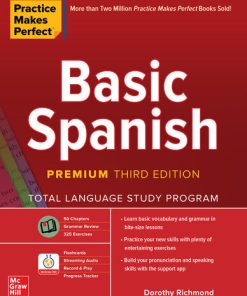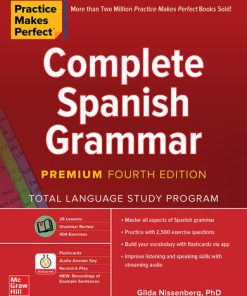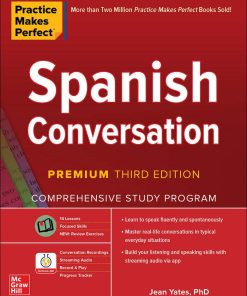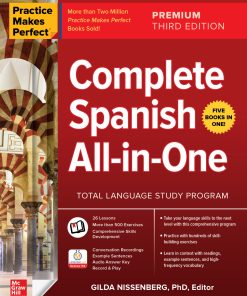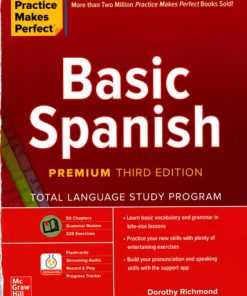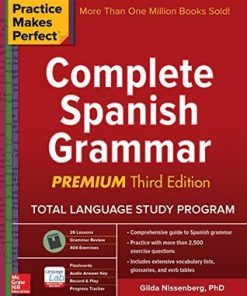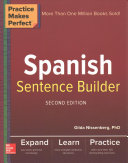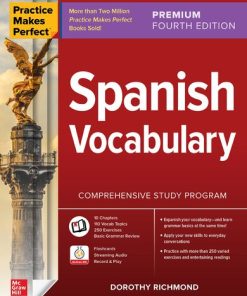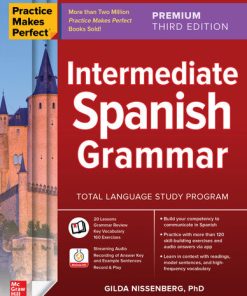Practice Makes Perfect Intermediate Spanish Grammar Premium Second Edition by Gilda Nissenberg 9781260121698 1260121690
$50.00 Original price was: $50.00.$25.00Current price is: $25.00.
Practice Makes Perfect Intermediate Spanish Grammar Premium Second Edition by Gilda Nissenberg – Ebook PDF Instant Download/Delivery:9781260121698, 1260121690
Full download Practice Makes Perfect Intermediate Spanish Grammar Premium Second Edition after payment
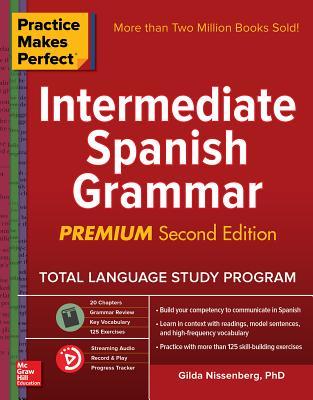
Product details:
ISBN 10: 1260121690
ISBN 13: 9781260121698
Author: Gilda Nissenberg
Publisher’s Note: Products purchased from Third Party sellers are not guaranteed by the publisher for quality, authenticity, or access to any online entitlements included with the product. The most hands-on, practical workbook for learning to read, write and speak Spanish flawlessly Practice, practice, practice—and improve your ability to read, write and speak Spanish as it’s really used. Practice Makes Perfect: Complete Spanish Grammar, Premium Fourth Edition has everything you need to progress from beginning to advanced fluency, from clear explanations and practical examples to all the practice required for language mastery. This updated, new edition boasts enhanced audio support online and via mobile app, ensuring you’ll speak the language as well as you write and speak it. In addition to recordings of the answers of more than 200 exercises in the book, the McGraw-Hill Language Lab app now includes audio for hundreds of example sentences throughout the book, along with text-to-speech pronunciation for all vocabulary flashcard lists. Practice Makes Perfect Complete Spanish Grammar, Premium Fourth Edition features: • 350 exercises in 26 units covering all aspects of Spanish grammar, with explanations that include useful/helpful comparisons with English grammar • Author has a proven teaching record, with extensive experience as an educator and curriculum developer • Clear explanations and thorough exercises • Recordings of exercise answers, and, new to this edition: example sentences and vocabulary lists • Exercises for use either in the classroom use or for individual study
Practice Makes Perfect Intermediate Spanish Grammar Premium Second Table of contents:
1. The Present Tense of Regular Verbs, Irregular Verbs, and Verbs with Spelling Changes
- Regular verbs in the present tense
- When is the present tense used in Spanish?
- Irregular verbs in the present tense
- Verbs with spelling changes in the present tense
- Dar, haber, hacer, and tener in expressions with a special meaning
2. The Present Tense of Verbs with Stem Changes
- Verbs ending in -ar and -er
- Verbs ending in -ir
- Verbs ending in -uir
3. Ser and Estar
- Similarities and differences between ser and estar
- When is ser used in Spanish?
- When is estar used in Spanish?
- Adjectives that change their meaning when used with either ser or estar
- Expressions with estar
4. The Preterit Tense
- Regular verbs in the preterit
- When is the preterit used in Spanish?
- Verbs with spelling changes in the preterit
- Stem-changing verbs in the preterit
- Irregular verbs in the preterit
- Verbs with a special meaning in the preterit
5. The Imperfect Tense
- Regular verbs in the imperfect
- Irregular verbs in the imperfect
- When is the imperfect used in Spanish?
- The imperfect and the preterit in the same sentence
6. More About the Preterit and the Imperfect
- Summary and contrast of the preterit and the imperfect
- Verbs with a special meaning: ponerse, volverse, and hacerse
7. The Future and the Conditional
- The future tense
- When is the future tense used in Spanish?
- Other ways of expressing the future in Spanish
- The conditional mood
- When is the conditional used in Spanish?
- Other uses of the conditional
8. Reflexive Verbs and Reflexive Constructions
- Reflexive verbs and pronouns
- More reflexive verbs
- Reflexive constructions with stem-changing and irregular verbs
- The use of reflexive verbs in Spanish
- Verbs that change meaning when used as reflexive verbs
- The commands in reflexive constructions
- The infinitive and present participle in reflexive constructions
- Reflexive constructions in reciprocal actions
- How to express “to become” in Spanish
- The reflexive construction in other tenses
9. The Progressive Tenses
- The forms of the present participle in regular, irregular, and stem-changing verbs
- Placement of reflexive pronouns and other object pronouns with the present participle
- When is the present progressive used in Spanish?
- The progressive forms in other tenses
- Verbs of motion in progressive tenses
- Present participle: Spanish compared to English
10. Compound Tenses: The Present Perfect and the Past Perfect
- The present perfect
- Past participles ending in -ído and irregular past participles
- When is the present perfect tense used in Spanish?
- The past perfect or pluperfect
- When is the past perfect used in Spanish?
- Other compound tense forms: the preterit perfect
- When is the preterit perfect tense used in Spanish?
- Haber + a participle: the Spanish equivalent of the perfect infinitive
- When is the infinitive of haber + a participle used in Spanish?
11. Compound Tenses: The Future Perfect and the Conditional Perfect
- The future perfect
- When is the future perfect used in Spanish?
- The conditional perfect
- When is the conditional perfect used in Spanish?
12. The Passive Voice and Passive Constructions
- The passive voice in Spanish
- When is the passive voice used in Spanish?
- The passive construction with the pronoun se
- When is the passive construction with se used in Spanish?
- Impersonal constructions used to substitute for passive constructions
13. The Subjunctive Mood: The Present and the Present Perfect Subjunctive Tenses in Noun Clauses
- The present subjunctive
- Verbs with spelling changes in the present subjunctive
- Verbs with stem changes in the present subjunctive
- Irregular verbs in the present indicative and in the present subjunctive
- Irregular verbs in the present subjunctive
- When is the present subjunctive used in Spanish?
- Other uses of the present subjunctive
- The present perfect subjunctive
- When is the present perfect subjunctive used in Spanish?
14. More Uses of the Subjunctive: Adverb and Relative Clauses
- The subjunctive in adverb clauses
- When is the subjunctive used in dependent adverb clauses in Spanish?
- Expressions that may or may not require the subjunctive
- When is the subjunctive not used in dependent adverb clauses in Spanish?
- More uses of the subjunctive: the subjunctive in adjective clauses
- When is the subjunctive used in adjective clauses?
- Other uses of the subjunctive
15. The Subjunctive Mood Past Tenses: The Imperfect and the Pluperfect Subjunctive
- The imperfect subjunctive
- When is the imperfect subjunctive used in Spanish?
- Other uses of the imperfect subjunctive
- The pluperfect subjunctive
- When is the pluperfect subjunctive used in Spanish?
- Other uses of the pluperfect subjunctive
- The imperfect and pluperfect subjunctive in contrary-to-fact conditional clauses
16. The Commands
- Formal or polite commands
- When are formal commands used in Spanish?
- Informal (tú) affirmative command forms
- Tú negative command forms
- Plural familiar (vosotros) affirmative command forms
- Vosotros negative command forms
- When are informal (tú) commands used in Spanish?
- Commands and the position of reflexive and object pronouns
- Other ways of expressing a command (nosotros)
17. Nouns and Articles
- Gender of nouns in Spanish: endings of nouns
- Masculine nouns and their endings in Spanish
- Feminine nouns and their endings in Spanish
- Other endings to consider for the gender of nouns
- Other nouns and their gender
- Plural of nouns
- Definite articles
- When are definite articles used in Spanish?
- More about the uses of definite articles in Spanish
- When are definite articles omitted in Spanish?
- Lo, the neuter article
- Indefinite articles
- When are indefinite articles used in Spanish?
- When are indefinite articles not used in Spanish?
18. Adjectives
- Gender and number of adjectives in Spanish
- Where are adjectives placed in Spanish?
- Other adjective forms used before nouns: the shortened forms
- Other considerations about the position of adjectives
- Words that function as adjectives
- Comparatives and superlatives
- Irregular comparative and superlative adjectives
- Other comparisons
19. Personal Pronouns
- Subject pronouns
- Uses of the subject pronouns
- Pronouns as objects of prepositions
- When are prepositional pronouns used in Spanish?
- Direct object pronouns
- When are direct object pronouns used in Spanish?
- Indirect object pronouns
- Where are indirect object pronouns placed?
- Double object pronouns
- How are double object pronouns used in Spanish?
- The indirect object pronoun with gustar and other verbs
20. Relative Pronouns
- Que: When is the relative pronoun que used in Spanish?
- Quien: When is the relative pronoun quien used in Spanish?
- El que and el cual: When are the relative pronouns el que and el cual and their forms used in Spanish?
- Lo que and lo cual: When are the relative pronouns lo que and lo cual used in Spanish?
- Relative pronouns after prepositions
- Cuyo, cuya: When are the relative adjectives cuyo, cuya used in Spanish?
21. Possessive and Demonstrative Adjectives and Pronouns
- Possessive adjectives and pronouns
- Possessive adjective forms: the short forms and the long forms
- When are the short and long forms of the possessive adjectives used in Spanish?
- Possessive pronouns
- Demonstrative adjectives
- When are the different forms of the demonstrative adjectives used in Spanish?
- Demonstrative pronouns
- The neuter forms of the demonstrative pronouns
22. Adverbs
- Adverb forms in Spanish
- Compound adverbs
- Other adverb forms: adverbial expressions
- Adjectives and nouns used as adverbs
- Comparisons with adverbs
- When are adverbs used in Spanish?
23. Prepositions
- Frequently used prepositions in Spanish
- Relationships of commonly used prepositions and compound prepositions
- The preposition a and the personal a
- Uses of prepositions and their English equivalents
- The uses of para and por
- Por in common idiomatic expressions
- Verbs that require the preposition a or de + an infinitive in Spanish
- Verbs with other prepositions
- Verbs that require a preposition in English but not in Spanish
24. Indefinite and Negative Words and Expressions
- Indefinite and negative words in Spanish
- When are indefinite and negative words used in Spanish?
- Other negative expressions
- The conjunctions pero and sino and negative expressions
- When are pero and sino used in Spanish?
25. Interrogative and Exclamatory Words
- Interrogative words and expressions
- Interrogative words in Spanish
- Other uses of interrogative words and expressions
- ¿Para qué? ¿Por qué?: When are they used in Spanish?
- Interrogative words and expressions in indirect questions
- Exclamations
26. Numbers
- Cardinal numbers
- When do we use cardinal numbers?
- Ordinal numbers
- Other numbers: fractions and multiple numbers
- Verb tables
- Glossaries
- Spanish-English glossary
- English-Spanish glossary
- Answer key
People also search for Practice Makes Perfect Intermediate Spanish Grammar Premium Second :
practice makes perfect intermediate spanish grammar pdf
practice makes perfect intermediate french grammar pdf
practice makes perfect intermediate english reading and comprehension pdf
english conversation (practice makes perfect intermediate
Tags:
Gilda Nissenberg,Practice Makes Perfect,Intermediate Spanish
You may also like…
Politics & Philosophy - Anthropology
Practice Makes Perfect: Complete Spanish Grammar, Premium Fourth Edition 4th Edition
Languages - General & Miscellaneous Languages - Reference
Languages - Spanish Language Reference
Practice Makes Perfect: Basic Spanish, Premium Third Edition
Languages - Spanish Language Reference
Languages - Spanish Language Reference
Practice Makes Perfect Spanish Sentence Builder, Second Edition Gilda Nissenberg
Languages - Spanish Language Reference
Practice Makes Perfect: Spanish Vocabulary, Premium 4th Edition
dictionaries & phrasebooks




